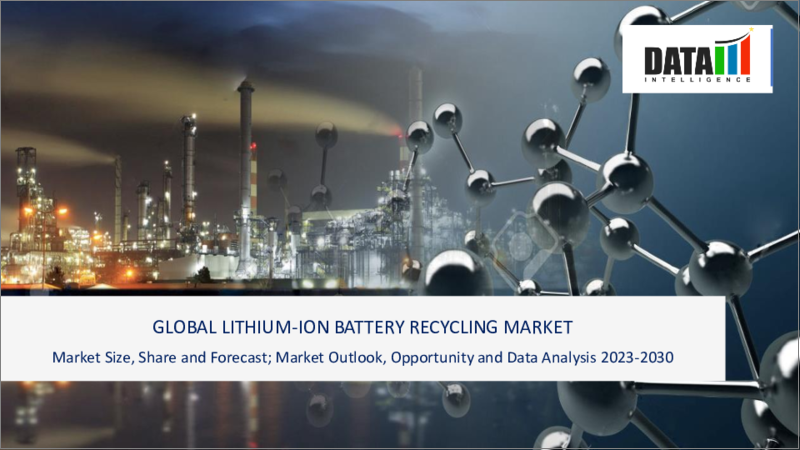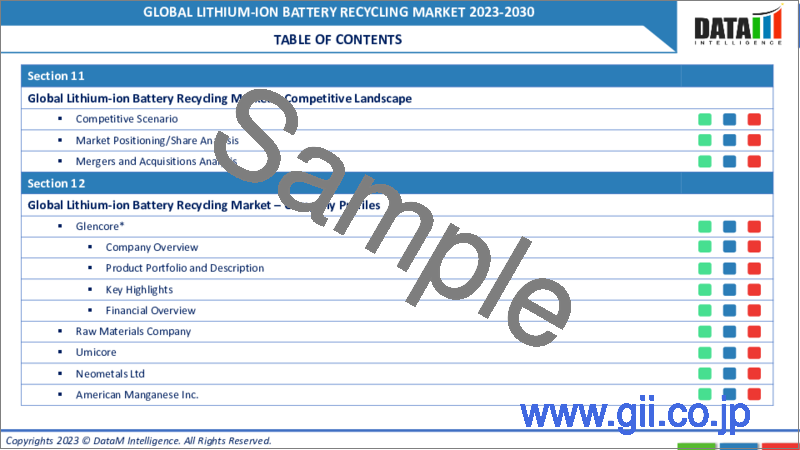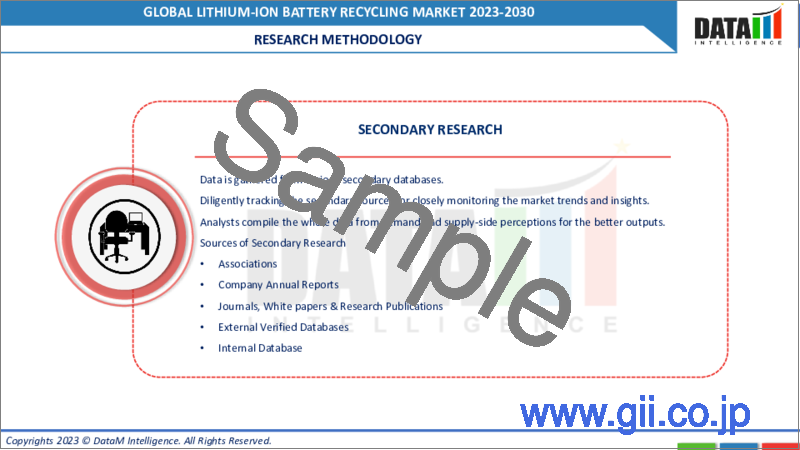|
|
市場調査レポート
商品コード
1304558
リチウムイオン電池リサイクルの世界市場-2023年~2030年Global Lithium-Ion Battery Recycling Market - 2023-2030 |
||||||
|
● お客様のご希望に応じて、既存データの加工や未掲載情報(例:国別セグメント)の追加などの対応が可能です。 詳細はお問い合わせください。 |
|||||||
| リチウムイオン電池リサイクルの世界市場-2023年~2030年 |
|
出版日: 2023年07月07日
発行: DataM Intelligence
ページ情報: 英文 205 Pages
納期: 約2営業日
|
- 全表示
- 概要
- 目次
市場概要
世界のリチウムイオン電池リサイクル市場は、2022年に61億米ドルに達し、2023~2030年の予測期間中にCAGR 22.3%で成長し、2030年には204億米ドルに達すると予測されています。リチウムイオン電池は、携帯電子機器、電気自動車、軍事・航空宇宙用途で普及しています。電池技術の進歩は、メンテナンス要件の低減と相まって、電気自動車の成長に拍車をかけています。
しかし、消費者製品におけるリチウムイオン電池の使用量の増加に伴い、爆発や不適切な廃棄などの潜在的な危険を防ぐためにリサイクルが必要とされています。リチウムイオン電池のリサイクル需要は、電気自動車開発への投資や電池リサイクルを促進するインセンティブなど、いくつかの要因によって推進されています。これらの電池の廃棄に関連するリスクを軽減するために、リサイクル工程は極めて重要になります。
北米は世界のリチウムイオン電池リサイクル市場で大きな成長を遂げており、市場シェアの5分の1以上を占めています。この成長は、政府による多額の投資と、同地域の共同研究開発努力によるものです。様々な技術セグメントの中でも、湿式冶金プロセスが急成長を遂げています。それぞれの技術セグメントでは、市場シェアの約3分の1を占めるところまで来ています。湿式冶金は、その強化された安全対策と高い回収率によって支持されています。
市場力学
技術の進歩と新しいリチウムイオン電池リサイクル装置の増加
1990年代のイントロダクション以来、リチウムイオン電池のコストは採用の大きな障壁となってきました。最先端のリチウムイオン電池の構成部品の多くは、補助金付きの価格で提供されています。しかし、リチウムイオン電池メーカーや自動車メーカーによる最近の発見や主張は、これらの電池の価格が大幅に低下することを予測し、主要プレーヤーが将来的に成長する機会を生み出しています。大規模製造、部品価格の低下、電池容量技術により、価格は下落しています。
リチウム電池の価格下落は、再生可能エネルギー貯蔵分野の拡大を促進し、リチウムイオン電池は他のすべての充電式電池を凌駕すると予測されています。その結果、使用済みリチウムイオン電池のリサイクル需要が高まることが予想されます。例えば、2021年7月23日、インドは最大の3GWhリチウムイオン電池製造・リサイクル工場を建設しました。それぞれの工場は、年間1GWh/1,000MWhの電池製造能力と2GWh/2,000MWhのリサイクル能力を統合しています。
普及と投資の増加
近年、電気自動車(EV)の販売台数は大きく伸びています。EV需要の増加は、環境意識、政府のインセンティブ、技術の進歩など、いくつかの要因によるものです。EVの販売台数は2021年に40%増加しました。さらに、電気自動車用リチウムイオン電池は中国がトップで、同国は電気自動車の世界販売の約40%を占めています。このように、エンドユーザーの増加とリチウムイオン電池の製造が、世界のリサイクルプラント市場を活性化させています。
さらに、様々な企業がリサイクルプラントのプロセスコストを下げ、環境汚染と戦うための新しいアプローチをもたらそうとしています。さらに、EVの主要プレーヤーもEVリチウムイオン電池のリサイクルの改善に貢献しています。例えば、2021年1月26日、Fortumはフィンランドの国家電池政策の発表に伴い、電池リサイクル活動の発展を発表しました。Fortumは2021年2月にフィンランドのイカアリネンに新しい機械式リサイクル処理工場を開設する予定です。
高い投資コスト
リチウムイオン電池設備の設置には、技術の収集、輸送、資源の管理に多額の投資が必要です。インドのような国では、B2Bセグメントでさえリサイクル業者が苦戦しており、まだ初期段階にあります。しかし、B2Cは今後数年間は遠い現実のままであろう。このように、インドではリサイクルのコストがリチウムイオン電池リサイクル市場の成長を妨げる大きな要因となっています。
しかし、インドでは、リチウムイオン電池のリサイクルコストは1Kgあたり米国1.20~1.33米ドル(1Kgあたり90~100ルピー)程度です。さらに、2020年のプレスリリースによると、自動車用最終パックの価値は、電池電気自動車では1Kgあたり4.0米ドル(1Kgあたり3.3ポンド)、プラグインハイブリッド電気自動車では1Kgあたり2.6米ドル(1Kgあたり2.2ポンド)です。しかし、米国を拠点とするOEMは、加工用に輸出されるリチウムイオン電池のリサイクル料金として1Kg当たり3.6~9.8米ドル(3~8ポンド)を支払っており、回収された材料は再利用する前に再購入しなければならないです。そのため、プロファイルマージンは投資額と比較して極端に示されています。
COVID-19影響分析
COVID-19パンデミックは、エネルギー部門やその他の生活分野に長期的な影響を与えました。COVID-19危機の間、様々な産業ニーズへの電力供給の継続性を維持し、消費者のニーズに応えることは、電力・公益事業者にとって大きな問題でした。
この分野では、安全基準や距離基準によって労働者の数を減らす必要性が課せられ、厳格な衛生管理の必要性が現場労働者や業務に直接影響しました。需要の減少は技術的な問題を引き起こし、システムエンジニアは配電レベルでの無効シャットダウンのリスクを回避するため、供給電圧と無効レベルを達成しようとしました。
さらに、海洋産業など他のセクターもCOVID-19の発生により市場シェアの減少に直面しており、リチウムイオンリサイクル市場の妨げとなっています。さらに、COVID-19による電力部門への影響も、市場の主要エンドユーザーのひとつであるリチウムイオン電池リサイクルの妨げとなっています。
しかし、ほとんどの国で生産設備が再開されつつあり、インド、米国、中国、その他の発展途上国などではワクチン接種が増加しているため、リチウム電池を含む製品の需要が高まっています。生産設備の再開と国境を越えた取引の再開は、サプライチェーンの混乱問題を軽減し、最近の市場の勢いの回復につながっており、予測期間中にこの製品の期待される市場ポテンシャルを達成することが期待されています。
目次
第1章 調査手法と調査範囲
第2章 定義と概要
第3章 エグゼクティブサマリー
第4章 市場力学
- 影響要因
- 促進要因
- 普及と投資の増加
- 電池の安全な廃棄とリサイクルに関する政府政策とEPAガイドラインの拡大
- 技術の進歩と新しいリチウムイオン電池リサイクル装置の増加
- 抑制要因
- 高い投資コスト
- 機会
- 影響分析
- 促進要因
第5章 産業分析
- ポーターのファイブフォース分析
- サプライチェーン分析
- 価格分析
- 規制分析
第6章 COVID-19分析
第7章 電池化学別
- リチウムマンガン酸化物(LMO)
- リチウム・ニッケル・マンガン・コバルト(NMC)
- リン酸鉄リチウム(LFP)
- 酸化チタン酸リチウム(LTO)
- リチウム・ニッケル・コバルト・アルミニウム酸化物(NCA)
第8章 技術別
- 湿式冶金プロセス
- 乾式製錬プロセス
- 機械的プロセス
- その他
第9章 エンドユーザー別
- 自動車
- 海洋
- 産業
- 電力
- その他
第10章 地域別
- 北米
- 米国
- カナダ
- メキシコ
- 欧州
- ドイツ
- 英国
- フランス
- イタリア
- ロシア
- その他欧州
- 南米
- ブラジル
- アルゼンチン
- その他南米
- アジア太平洋
- 中国
- インド
- 日本
- オーストラリア
- その他アジア太平洋地域
- 中東・アフリカ
第11章 競合情勢
- 競合シナリオ
- 市況/シェア分析
- M&A分析
第12章 企業プロファイル
- Glencore
- 会社概要
- 製品ポートフォリオと説明
- 財務概要
- 最近の動向
- Raw Materials Company
- Umicore
- Neometals Ltd
- American Manganese Inc.
- Retriev Technologies
- Li-Cycle Corp
- SNAM(A subsidiary of Floridienne Group)
- TES
- Duesenfeld GmbH
第13章 付録
Market Overview
The Global Lithium-Ion Battery Recycling Market reached US$ 6.1 billion in 2022 and is expected to reach US$ 20.4 billion by 2030, growing with a CAGR of 22.3% during the forecast period 2023-2030. Lithium-ion batteries have become popular in portable electronics, electric vehicles, and military and aerospace applications. The advancement of battery technology, coupled with reduced maintenance requirements, has fueled the growth of electric vehicles.
However, with the increasing usage of lithium-ion batteries in consumer products, recycling is needed to prevent potential hazards, such as explosions and improper disposal. The demand for lithium-ion battery recycling is driven by several factors, including investments in electric vehicle development and incentives to promote battery recycling. The recycling process becomes crucial to mitigate the risks associated with the disposal of these batteries.
North America is experiencing significant growth in the global lithium-ion battery recycling market, accounting for more than one-fifth of the market share. The growth can be attributed to substantial government investments and the region's collaborative research and development efforts. Among the various technology segments, the hydrometallurgy process is witnessing rapid growth. The respective segment is close to capturing approximately one-third of the market share in the technology segment. Hydrometallurgy is favored due to its enhanced safety measures and high recovery rate.
Market Dynamics
Technological Advancements and Increasing Number of New Lithium-Ion Battery Recycling Units
Since its introduction in the 1990s, the cost of lithium-ion batteries has been a major barrier to adoption. Many components of a state-of-the-art lithium-ion battery are given at subsidized prices. However, recent discoveries and claims made by lithium-ion battery manufacturers and automotive manufacturers predict that the prices of these batteries will drop significantly, creating opportunities for key players to grow in the future. Pricing is falling due to large-scale manufacturing, decreasing component prices and battery capacity technologies.
The falling prices of lithium batteries are predicted to fuel the expansion of the renewable energy storage sector, with lithium-ion batteries expected to outperform all other rechargeable batteries. The respective fact, in turn, is likely to raise the demand for used lithium-ion batteries to be recycled. For instance, on July 23, 2021, India constructed its largest 3 GWh Li-ion battery manufacturing and recycling factory. The respective factory integrates battery manufacturing capacity of 1 GWh/ 1,000 MWh and 2GWh/ 2,000 MWh of recycling per annum.
Increasing Adoption and Investment
The sales of electric vehicles (EVs) have been experiencing significant growth in recent years. The increasing demand for EVs can be attributed to several factors, including environmental consciousness, government incentives, and technological advancements. EV sales increased by 40% in 2021. Furthermore, China topped the lithium-ion batteries for the electric vehicle market and the country accounts for around 40% of the global sale of the electric vehicle. Thus, these rising numbers of end-users and Li-ion battery manufacturing are triggering the global recycling plants' market.
Additionally, various companies are trying to bring a new approach to drop down the process cost of a recycling plant and combat environmental pollution. In addition EV key players are also contributing to improving EVs lithium-ion batteries recycling. For instance, on January 26, 2021, Fortum has announced the development of its battery recycling activities in line with the announcement of Finland's national battery policy. Fortum plans to open a new mechanical recycling processing plant in Ikaalinen, Finland, in February 2021.
High Investment Cost
Lithium-ion battery facility setup requires high investment in technology collection, transportation and management of resources. Country like India is still in the initial phase as the recyclers struggle even in the B2B segment. However, B2C would remain a distant reality for the next few years. Thus the cost of recycling in India remained a major hindrance factor for the growth of the Lithium-ion battery recycling market.
However, in India, lithium-ion battery recycling costs around US$ 1.20 -1.33 per Kg (Rs. 90-100 per Kg). Furthermore, As per the 2020 press release, The value of end-of-use automotive packs is US$ 4.0 per Kg (£3.3 per Kg) for battery electric vehicles and US$ 2.6 per Kg (£2.2 per Kg) for plug-in hybrid electric vehicles. But UK-based OEMs are paying US$ 3.6- 9.8 per Kg (£3-8 per Kg) in recycling charges for Li-ion batteries that are exported for processing, with recovered materials having to be repurchased before they can be reused. Therfore, the profile margins are extreme shown compared to the investment.
COVID-19 Impact Analysis
The COVID-19 pandemic has had a long-term impact on the energy sector and other areas of life. During the COVID-19 crisis, maintaining the continuity of power supply to various industry needs and serving the needs of consumers was a major issue for power and utility providers.
The need for fewer workers in this sector has been imposed by safety and distance standards and the need for strict hygiene directly impacts field workers and operations. The reduced demand has created technical issues, with system engineers attempting to reach supply voltage and reactive levels to avoid the risk of reactive shutdowns at distribution levels.
Furthermore, other sectors, such as marine industries, have also faced market share reduction due to the COVID-19 outbreak, which hampers the lithium-ion recycling market. Additionally, the impact on the power sector due to COVID-19 has also hampered lithium-ion battery recycling as it is one of the major end-users for the market.
However, most countries are regaining their production units and increasing vaccination in countries like India, the U.S., China and other developing countries have escalated the demand for products involving lithium batteries. The reopening of production units and reopening of cross-border trading has reduced supply chain disruption problems leading to regaining the market momentum in recent times and expected to achieve the expected market potential for the product in the forecast period.
Segment Analysis
The Global Lithium-Ion Battery Recycling Market is segmented based on battery chemistry, technology, end-user and region.
High Energy Density and Availability in Various Configurations
Because of the substantial price drop in recent years, since 2015, there has been an upsurge in the use of NMC batteries in the automotive sector. NMC batteries will be used in mass-produced electric vehicles, according to major global automakers. Tesla, for example, employs CATL's LiNi0.6Mn0.2Co0.2O2 (NMC622) batteries in China (Shirouzu och Lienert 2020). NMC batteries (LiNi1/3Mn1/3Co1/3O2 (NMC111), LiNi0.6Mn0.2Co0.2O2 (NMC622), LiNi0.8Mn0.1Co0.1O2 (NMC811)) are purchased by both Tesla and Audi from LG Chem (Shirouzu och Lienert 2020). (LG Chem 2020).
NMC batteries have a high energy density and are available in various configurations, including NMC111 (equal amounts nickel, manganese and cobalt) and NMC532/622. The Chevrolet Bolt and Nissan Leaf are two electric vehicles that employ these batteries. The Lithium-Nickel Manganese Cobalt (NMC) segment in the Global Lithium-Ion Battery Recycling Market was valued at US$ 4.4 billion in 2022.
Due to its widespread use in applications such as e-bikes and other electric powertrains, the lithium nickel manganese cobalt category is expected to hold a healthy proportion of the market. NMC batteries, due to their high Cobalt content, are intriguing to recycle. The presence of an established end-of-life battery collecting network is another element driving the segment's growth.
Geographical Analysis
Rapidly Escalating Sales of Electric Vehicles and Energy Storage System for Residential and Commercial Applications
The Asia-Pacific Lithium-Ion Battery Recycling Market was valued at US$ 2.6 billion in 2022. The sales for electric vehicles are rapidly escalating in Asian countries such as Japan, China and South Korea. With the increased market of electric vehicles in Asian economies, lithium-ion batteries will expand simultaneously, improving lithium-ion battery recycling.
For instance, To limit the amount of EV battery waste, an Indian EV manufacturer, eBikeGo, has launched a recycling campaign for their lithium batteries in 2021. The company will take the battery for recycling when the capacity of an electric vehicle's battery drops by around 25%. Recycling Li-ion batteries will help to bring down the pricing of the batteries in the future.
Similarly, the energy storage system for residential and commercial applications further drives the market in the region. Also, China topped the lithium-ion batteries for the electric vehicle market and the country accounts for around 40% of the global sale of electric vehicles.
Thus, these rising numbers of end-users and manufacturing of Li-ion batteries in the region are triggering the recycling plants' market in the region. Government authorities in the region are also promoting the production of electric vehicles and lithium-ion batteries, which is expected to surge the market demand.
Competitive Landscape
The major global players include: Glencore, Raw Materials Company, Umicore, Neometals Ltd, American Manganese Inc., Retriev Technologies, Li-Cycle Corp, SNAM (A subsidiary of Floridienne Group), TES and Duesenfeld GmbH.
Why Purchase the Report?
- To visualize the Global Lithium-Ion Battery Recycling Market segmentation based on battery chemistry, technology, end-user and region, as well as understand key commercial assets and players.
- Identify commercial opportunities by analyzing trends and co-development.
- Excel data sheet with numerous lithium-ion battery recycling market-level data points with all segments.
- PDF report consists of a comprehensive analysis after exhaustive qualitative interviews and an in-depth study.
- Product mapping available as Excel consisting of key products of all the major players.
The Global Lithium-Ion Battery Recycling Market Report Would Provide Approximately 61 Tables, 62 Figures And 205 Pages.
Target Audience 2023
- Manufacturers/ Buyers
- Industry Investors/Investment Bankers
- Research Professionals
- Emerging Companies
Table of Contents
1. Methodology and Scope
- 1.1. Research Methodology
- 1.2. Research Objective and Scope of the Report
2. Definition and Overview
3. Executive Summary
- 3.1. Snippet by Battery Chemistry
- 3.2. Snippet by Technology
- 3.3. Snippet by End-User
- 3.4. Snippet by Region
4. Dynamics
- 4.1. Impacting Factors
- 4.1.1. Drivers
- 4.1.1.1. Increasing Adoption and Investment
- 4.1.1.2. Growing Government Policies and EPA Guidelines Regarding the Safe Disposal and Recycling of Batteries
- 4.1.1.3. Technological Advancements and Increasing Number of New Lithium-Ion Battery Recycling Units
- 4.1.2. Restraints
- 4.1.2.1. High Investment Cost
- 4.1.3. Opportunity
- 4.1.4. Impact Analysis
- 4.1.1. Drivers
5. Industry Analysis
- 5.1. Porter's Five Force Analysis
- 5.2. Supply Chain Analysis
- 5.3. Pricing Analysis
- 5.4. Regulatory Analysis
6. COVID-19 Analysis
- 6.1. Analysis of COVID-19
- 6.1.1. Scenario Before COVID
- 6.1.2. Scenario During COVID
- 6.1.3. Scenario Post COVID
- 6.2. Pricing Dynamics Amid COVID-19
- 6.3. Demand-Supply Spectrum
- 6.4. Government Initiatives Related to the Market During the Pandemic
- 6.5. Manufacturers' Strategic Initiatives
- 6.6. Conclusion
7. By Battery Chemistry
- 7.1. Introduction
- 7.1.1. Market Size Analysis and Y-o-Y Growth Analysis (%), By Battery Chemistry
- 7.1.2. Market Attractiveness Index, By Battery Chemistry
- 7.2. Lithium-Manganese Oxide (LMO)*
- 7.2.1. Introduction
- 7.2.2. Market Size Analysis and Y-o-Y Growth Analysis (%)
- 7.3. Lithium-Nickel Manganese Cobalt (NMC)
- 7.4. Lithium-Iron Phosphate (LFP)
- 7.5. Lithium-Titanate Oxide (LTO)
- 7.6. Lithium-Nickel Cobalt Aluminum Oxide (NCA)
8. By Technology
- 8.1. Introduction
- 8.1.1. Market Size Analysis and Y-o-Y Growth Analysis (%), By Technology
- 8.1.2. Market Attractiveness Index, By Technology
- 8.2. Hydrometallurgy Process*
- 8.2.1. Introduction
- 8.2.2. Market Size Analysis and Y-o-Y Growth Analysis (%)
- 8.3. Pyrometallurgy Process
- 8.4. Mechanical Process
- 8.5. Others
9. By End-User
- 9.1. Introduction
- 9.1.1. Market Size Analysis and Y-o-Y Growth Analysis (%), By End-User
- 9.1.2. Market Attractiveness Index, By End-User
- 9.2. Automotive*
- 9.2.1. Introduction
- 9.2.2. Market Size Analysis and Y-o-Y Growth Analysis (%)
- 9.3. Marine
- 9.4. Industrial
- 9.5. Power
- 9.6. Others
10. By Region
- 10.1. Introduction
- 10.1.1. Market Size Analysis and Y-o-Y Growth Analysis (%), By Region
- 10.1.2. Market Attractiveness Index, By Region
- 10.2. North America
- 10.2.1. Introduction
- 10.2.2. Key Region-Specific Dynamics
- 10.2.3. Market Size Analysis and Y-o-Y Growth Analysis (%), By Battery Chemistry
- 10.2.4. Market Size Analysis and Y-o-Y Growth Analysis (%), By Technology
- 10.2.5. Market Size Analysis and Y-o-Y Growth Analysis (%), By End-User
- 10.2.6. Market Size Analysis and Y-o-Y Growth Analysis (%), By Country
- 10.2.6.1. The U.S.
- 10.2.6.2. Canada
- 10.2.6.3. Mexico
- 10.3. Europe
- 10.3.1. Introduction
- 10.3.2. Key Region-Specific Dynamics
- 10.3.3. Market Size Analysis and Y-o-Y Growth Analysis (%), By Battery Chemistry
- 10.3.4. Market Size Analysis and Y-o-Y Growth Analysis (%), By Technology
- 10.3.5. Market Size Analysis and Y-o-Y Growth Analysis (%), By End-User
- 10.3.6. Market Size Analysis and Y-o-Y Growth Analysis (%), By Country
- 10.3.6.1. Germany
- 10.3.6.2. The UK
- 10.3.6.3. France
- 10.3.6.4. Italy
- 10.3.6.5. Russia
- 10.3.6.6. Rest of Europe
- 10.4. South America
- 10.4.1. Introduction
- 10.4.2. Key Region-Specific Dynamics
- 10.4.3. Market Size Analysis and Y-o-Y Growth Analysis (%), By Battery Chemistry
- 10.4.4. Market Size Analysis and Y-o-Y Growth Analysis (%), By Technology
- 10.4.5. Market Size Analysis and Y-o-Y Growth Analysis (%), By End-User
- 10.4.6. Market Size Analysis and Y-o-Y Growth Analysis (%), By Country
- 10.4.6.1. Brazil
- 10.4.6.2. Argentina
- 10.4.6.3. Rest of South America
- 10.5. Asia-Pacific
- 10.5.1. Introduction
- 10.5.2. Key Region-Specific Dynamics
- 10.5.3. Market Size Analysis and Y-o-Y Growth Analysis (%), By Battery Chemistry
- 10.5.4. Market Size Analysis and Y-o-Y Growth Analysis (%), By Technology
- 10.5.5. Market Size Analysis and Y-o-Y Growth Analysis (%), By End-User
- 10.5.6. Market Size Analysis and Y-o-Y Growth Analysis (%), By Country
- 10.5.6.1. China
- 10.5.6.2. India
- 10.5.6.3. Japan
- 10.5.6.4. Australia
- 10.5.6.5. Rest of Asia-Pacific
- 10.6. Middle East and Africa
- 10.6.1. Introduction
- 10.6.2. Key Region-Specific Dynamics
- 10.6.3. Market Size Analysis and Y-o-Y Growth Analysis (%), By Battery Chemistry
- 10.6.4. Market Size Analysis and Y-o-Y Growth Analysis (%), By Technology
11. Competitive Landscape
- 11.1. Competitive Scenario
- 11.2. Market Positioning/Share Analysis
- 11.3. Mergers and Acquisitions Analysis
12. Company Profiles
- 12.1. Glencore*
- 12.1.1. Company Overview
- 12.1.2. Product Portfolio and Description
- 12.1.3. Financial Overview
- 12.1.4. Recent Developments
- 12.2. Raw Materials Company
- 12.3. Umicore
- 12.4. Neometals Ltd
- 12.5. American Manganese Inc.
- 12.6. Retriev Technologies
- 12.7. Li-Cycle Corp
- 12.8. SNAM (A subsidiary of Floridienne Group)
- 12.9. TES
- 12.10. Duesenfeld GmbH
LIST NOT EXHAUSTIVE
13. Appendix
- 13.1. About Us and Services
- 13.2. Contact Us




